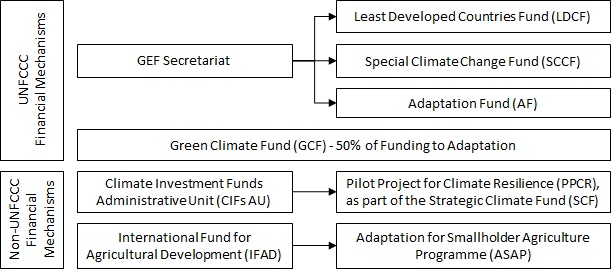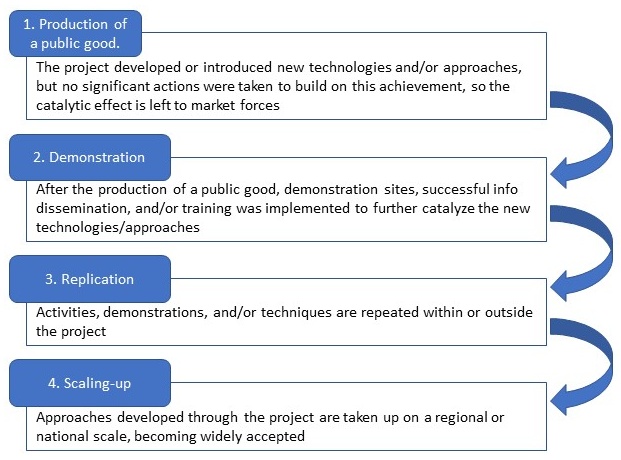Program evaluations of the LDCF and the SCCF
For those of you who haven't heard of the LDCF and SCCF before; the Least Developed Countries Fund (LDCF) is a climate fund, established during the UNFCCC COP meeting in Marrakech in 2001, that focuses on - among other things - providing support to least developed countries' (LDCs') climate change adaptation efforts. The Special Climate Change Fund was established at the same time, and has a broader mandate. SCCF funds can be accessed by ‘Parties not included in Annex I of the UNFCCC' (read; low and middle income developing economies) and with its broad scope it covers climate change adaptation as well as mitigation, with a special focus on technology transfer – though the focus of projects is mostly on adaptation.(1) These are two of only a limited number of multilateral funds providing funding for innovative adaptation projects. The Global Environment Facility (GEF) is entrusted with the administration and financial operation of the both the LDCF and SCCF.

The multilateral funds all have their specific focus or niche. For example, the Adaptation Fund's niche has been community-based adaptation, while the Green Climate Fund has taken previously financed concepts to scale, in order to achieve transformational impact. The SCCF has focused more on highly innovative approaches in new and emerging adaptation areas, aiming to provide a basis for upscaling by other financing mechanisms. The LDCF has supported Least Developed Countries in the development and implementation of their National Adaptation Programmes of Action (NAPAs) and recently their National Adaptation Plans (NAPs) process.
Over the past two years, the Independent Evaluation Office (IEO) of the GEF has conducted a program evaluation of the LDCF as well as a program evaluation of the SCCF. The main objective of both evaluations was to provide evaluative evidence on the progress towards LDCF/SCCF objectives, major achievements and lessons learned since their establishment. In this blog post I will share some of the findings of these two evaluations.
The LDCF/SCCF Portfolio
Based on data from the LDCF and SCCF program evaluations (2016 and 2017 respectively), the LDCF/SCCF project portfolio consists of 297 projects that entered the work programs of these Funds, meaning these have been Council approved, CEO endorsed/approved, are under implementation or have been completed. These projects received a total of $1.37 billion in LDCF/SCCF funding and $6.88 billion in co-financing. Seventy-six percent of the projects are full-size projects, and most projects were approved under the fifth replenishment of the GEF, GEF-5. UNDP (United Nations Development Programme), UNEP (United Nations Environment Programme) and the World Bank hold the largest share of LDCF projects, and UNDP, World Bank and IFAD (International Fund for Agricultural Development) hold the largest share of SCCF projects, both in number of projects and grant value.
Relevance of the Funds
The relevance of LDCF/SCCF funding was assessed against UNFCCC guidance and decisions, and GEF's objectives (shown below) and strategic pillars for climate change adaptation. The SCCF does have a mitigation component as part of the technology transfer focus, but this element is rather small in funding size and has not been assessed against UNFCCC decisions or GEF mitigation strategies.

LDCF/SCCF funding has supported activities that, for the most part, are highly relevant to UNFCCC decisions, GEF objectives, and GEF strategic pillars for climate change adaptation. Synergies between focal areas are mainly to be found between the climate change, biodiversity and land degradation focal areas.
Project Portfolio Analysis
For both Funds, a project portfolio analysis took place, looking at supported projects when entering the work program; first by means of a quality-at-entry review, and secondly by analyzing the performance of completed projects. The quality-at-entry review showed that 98.4 percent of LDCF/SCCF funded implementation projects have a high to very high probability of delivering tangible adaptation benefits.
The second analysis focused on 27 completed LDCF/SCCF projects, and more specifically looked at their ‘catalytic effects'; how far do they move down the ‘catalytic chain' from producing goods and services, to ultimately scaling-up and scaling-out.
 The analysis found that virtually all projects achieved - at least to a moderate extent - the first two effects on the catalytic chain, namely ‘production of a public good' and ‘demonstration'. Farmer-focused projects were the most typical, with - for example - drought resistant crop varieties introduced and demonstrated to new farmers and communities. Performance was not as strong against the latter two catalytic steps, 'replication' and 'scaling-up', nevertheless over two third of the projects did deliver ‘replication' to at least a moderate extent, and half of projects demonstrated a degree of ‘scaling-up' (again, to at least a moderate extent).
The analysis found that virtually all projects achieved - at least to a moderate extent - the first two effects on the catalytic chain, namely ‘production of a public good' and ‘demonstration'. Farmer-focused projects were the most typical, with - for example - drought resistant crop varieties introduced and demonstrated to new farmers and communities. Performance was not as strong against the latter two catalytic steps, 'replication' and 'scaling-up', nevertheless over two third of the projects did deliver ‘replication' to at least a moderate extent, and half of projects demonstrated a degree of ‘scaling-up' (again, to at least a moderate extent).
It should be noted that the LDCF and SCCF are typically focused on demonstration projects and the piloting of innovations; the ultimate catalytic effect of scaling-up often demands further investments. Most projects had obvious potential to achieve the ultimate catalytic goal of scaling-up, but the key constraint to actual scaling-up is the post-implementation difficulty in securing sufficient resources for larger scale follow-up projects and/or mainstreaming the work within, for example, national budgets.
In terms of sustainability of project outcomes, 75 percent of completed projects received ratings in the likely range, while the remaining projects were rated ‘moderately unlikely.' Most projects had obvious potential to achieve the ultimate catalytic goal of scaling-up, but the key constraint to actual scaling-up was the post-implementation difficulty in securing sufficient resources and/or mainstreaming the work within, for example, national budgets.
Resources; supply and demand
Despite the continued relevance of the Funds, their popularity amongst non-Annex I countries, and evidence that tangible adaptation results are being delivered, the LDCF/SCCF resources have been completely inadequate to meet demand. Both Funds are replenished through voluntary contributions and pledges have been made in an ad hoc manner. Unpredictability of funding creates uncertainty for GEF Agencies and countries reliant on LDCF/SCCF support for the implementation of their primary climate change adaptation priorities. It also negatively influences stakeholders' perception of the Funds' transparency, and overall impacts the Funds' efficiency; project concepts might be outdated by the time funding is available for the projects brought forward. SCCF stakeholders indicated that the lack of resources is creating a vicious circle: no resources are available, so no proposals are developed, which can be interpreted by donors as limited interest or lack of demand, so donors do not provide resources.
Recap
The LDCF and SCCF remain highly relevant, very popular among recipient countries, and both Funds have a strong value proposition in terms of delivering tangible adaptation benefits and delivering on those catalytic effects within their scope. The voluntary nature of their replenishment and no clear expectations towards future contributions impacts the efficiency and transparency of the Funds. It is recommended to develop funding mechanisms for the LDCF and SCCF that ensure predictable, adequate and sustainable financing. It is also recommended to see how successful demonstration projects and innovative pilots could be further scaled up though other climate finance mechanisms; the Green Climate Fund would be an obvious partner.
Some Resources:
- IEO, Program Evaluation of the LDCF, September 2016. Council Document GEF/LDCF.SCCF.20/ME/02.
- IEO, Program Evaluation of the SCCF, May 2017. Council Document GEF/LDCF.SCCF.22/ME/02.
- GEF, GEF Programming Strategy on Adaptation to Climate Change for the Least Developed Countries Fund (LDCF) and the Special Climate Change Fund (SCCF), May 05, 2014. Council Document GEF/LDCF.SCCF.16/03/Rev.01.
- GEF, Updated Results-Based Management Framework for Adaptation to Climate Change under the Least Developed Countries Fund (LDCF) and the Special Climate Change Fund (SCCF), October 15, 2014. Council Document GEF/LDCF.SCCF.17/05/Rev.01.
Other relevant evaluations:
- IEO/DANIDA, Joint External Evaluation: Operation of the Least Developed Countries Fund for Adaptation to Climate Change, November 2009. Council document GEF/LDCF.SCCF.07/Inf.04.
- IEO, Evaluation of the Special Climate Change Fund, October 2011. Council Document GEF/LDCF.SCCF.11/ME/02.
- IEO, Evaluation of the Special Climate Change Fund, Volume 1: Evaluation Report, April 2012. Evaluation Report No. 73.
- IEO, Evaluation of the GEF Focal Area Strategies, January 2013. Evaluation Report No. 78.
- IEO, The Fifth Overall Performance Study (OPS5), May 2014.
(1) The SCCF consists of two funded activity windows; SCCF-A focuses on adaptation, and SCCF-B focuses on technology transfer for adaptation as well as mitigation. Of the total SCCF funding of US$ 333.45 million only US$ 45.7 million went to the SCCF-B window, and a considerably smaller amount was dedicated to mitigation. Because of that, the Program Evaluation of the SCCF focused specifically on adaptation benefits.



